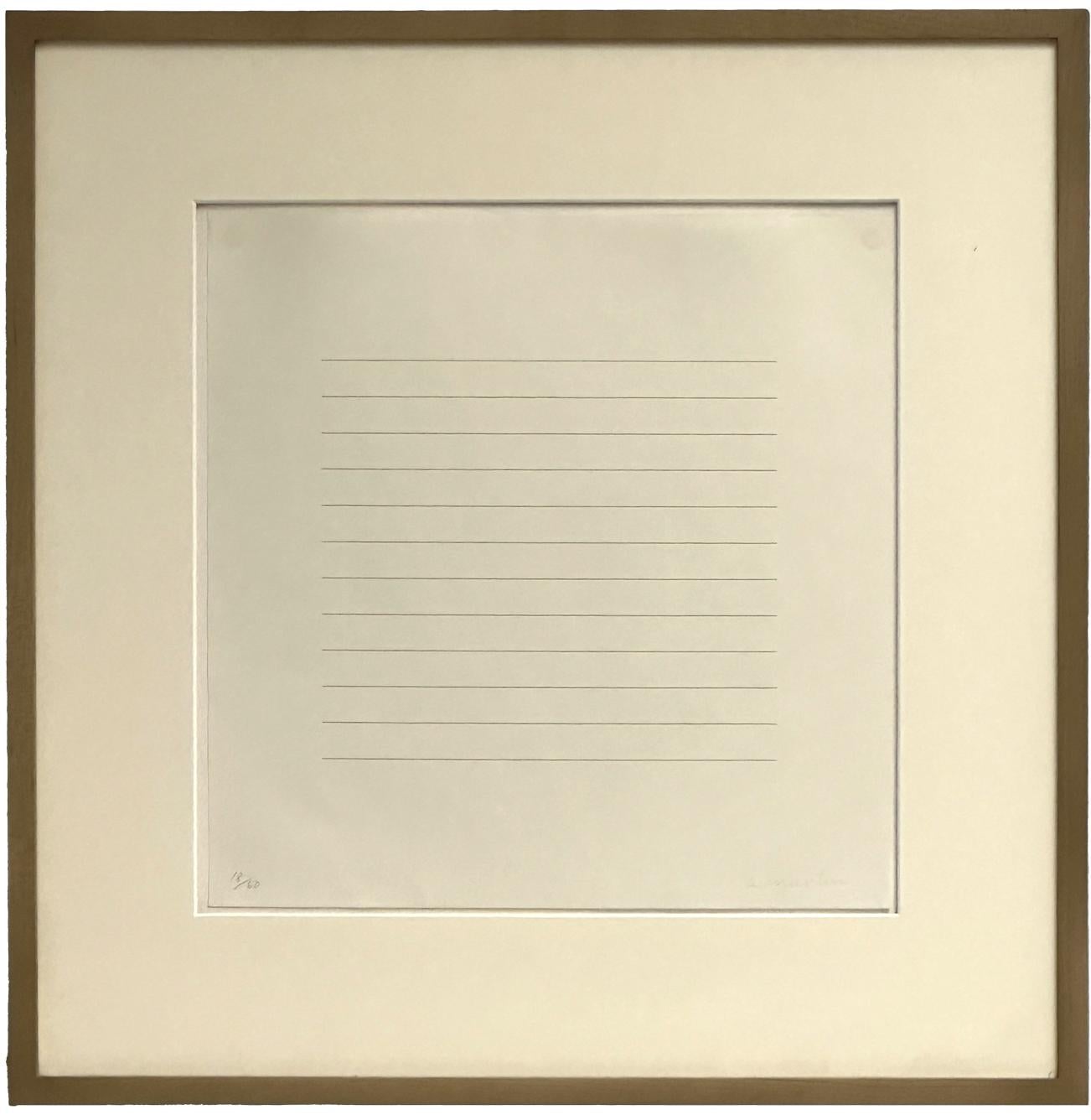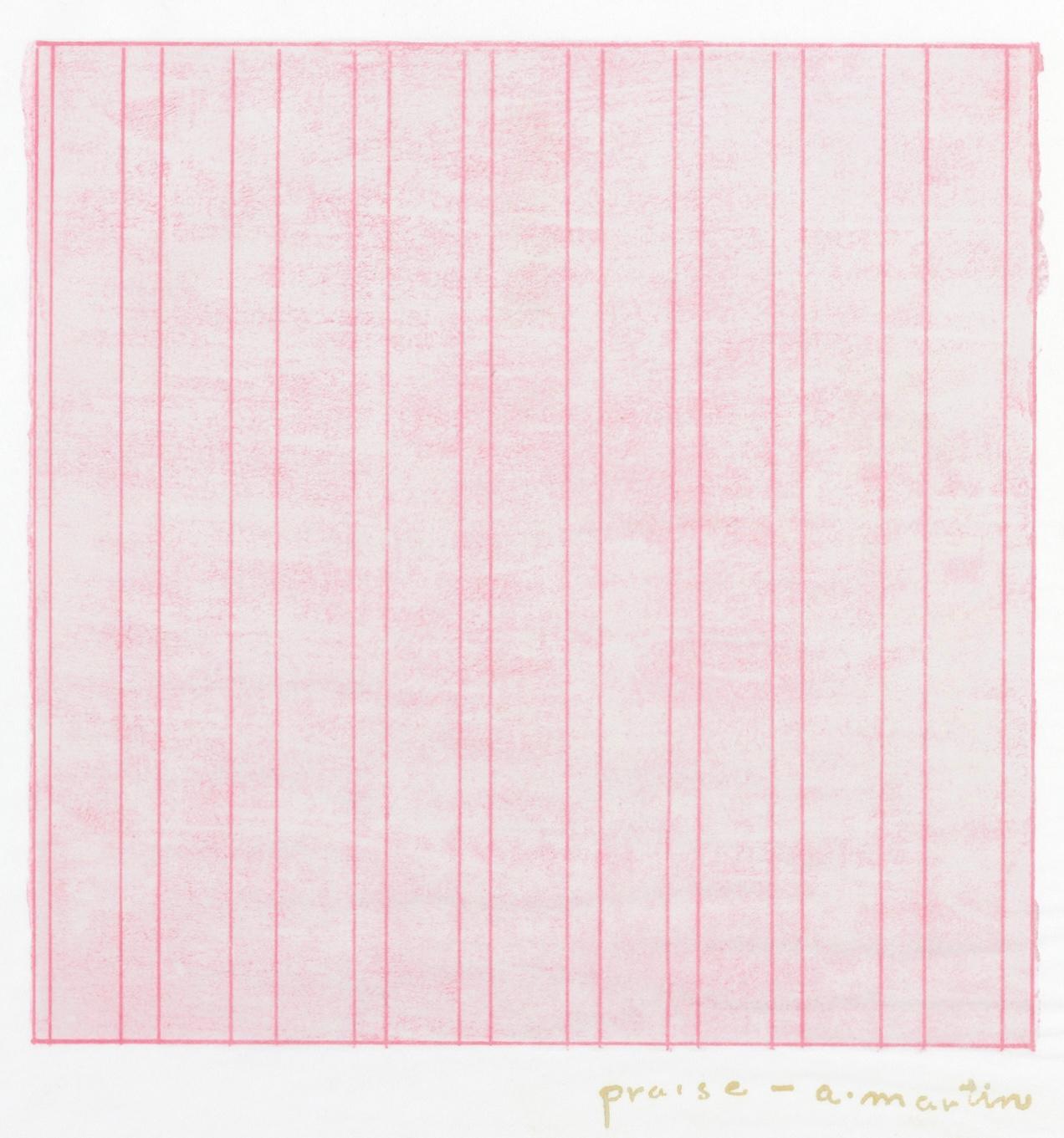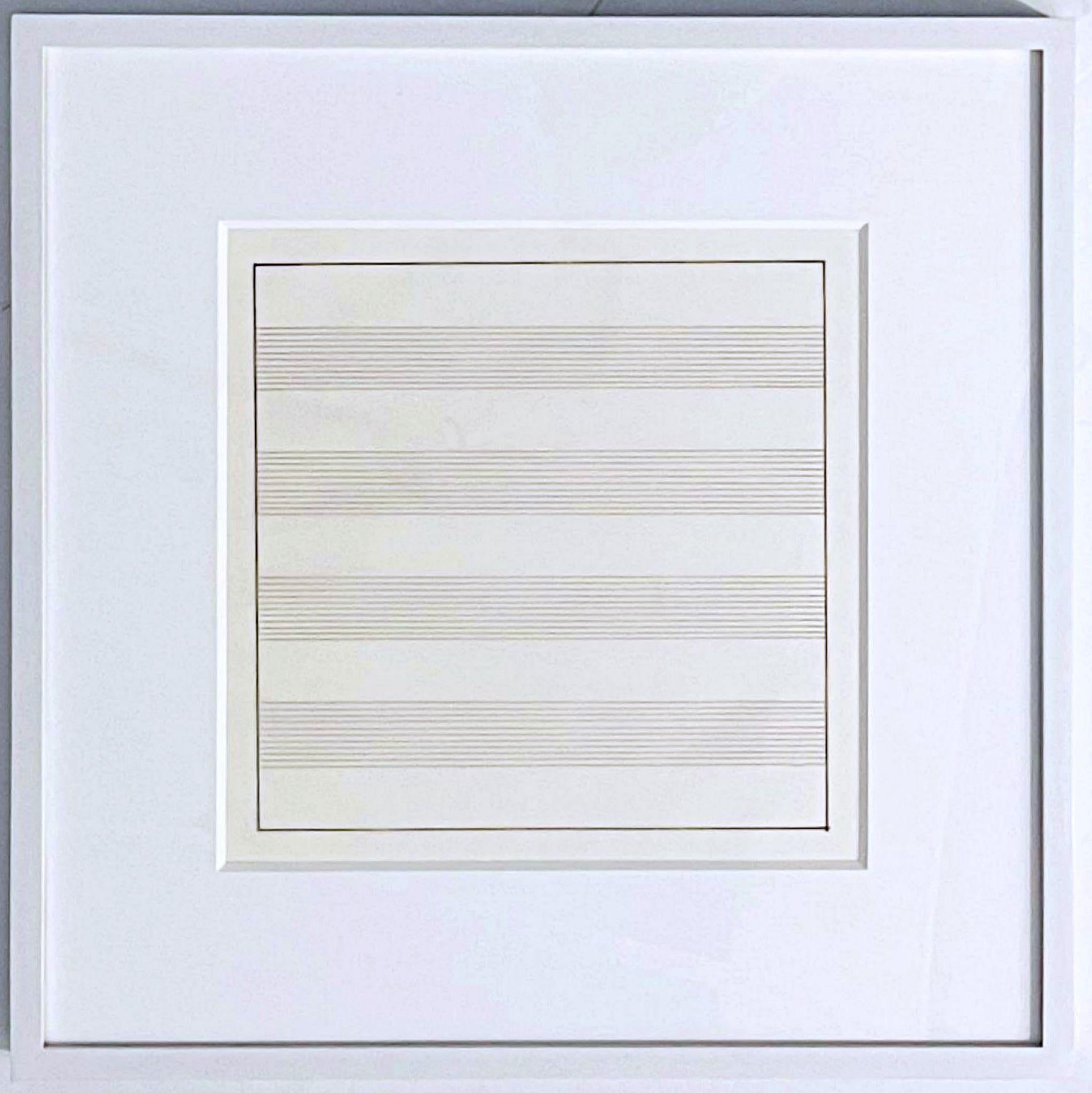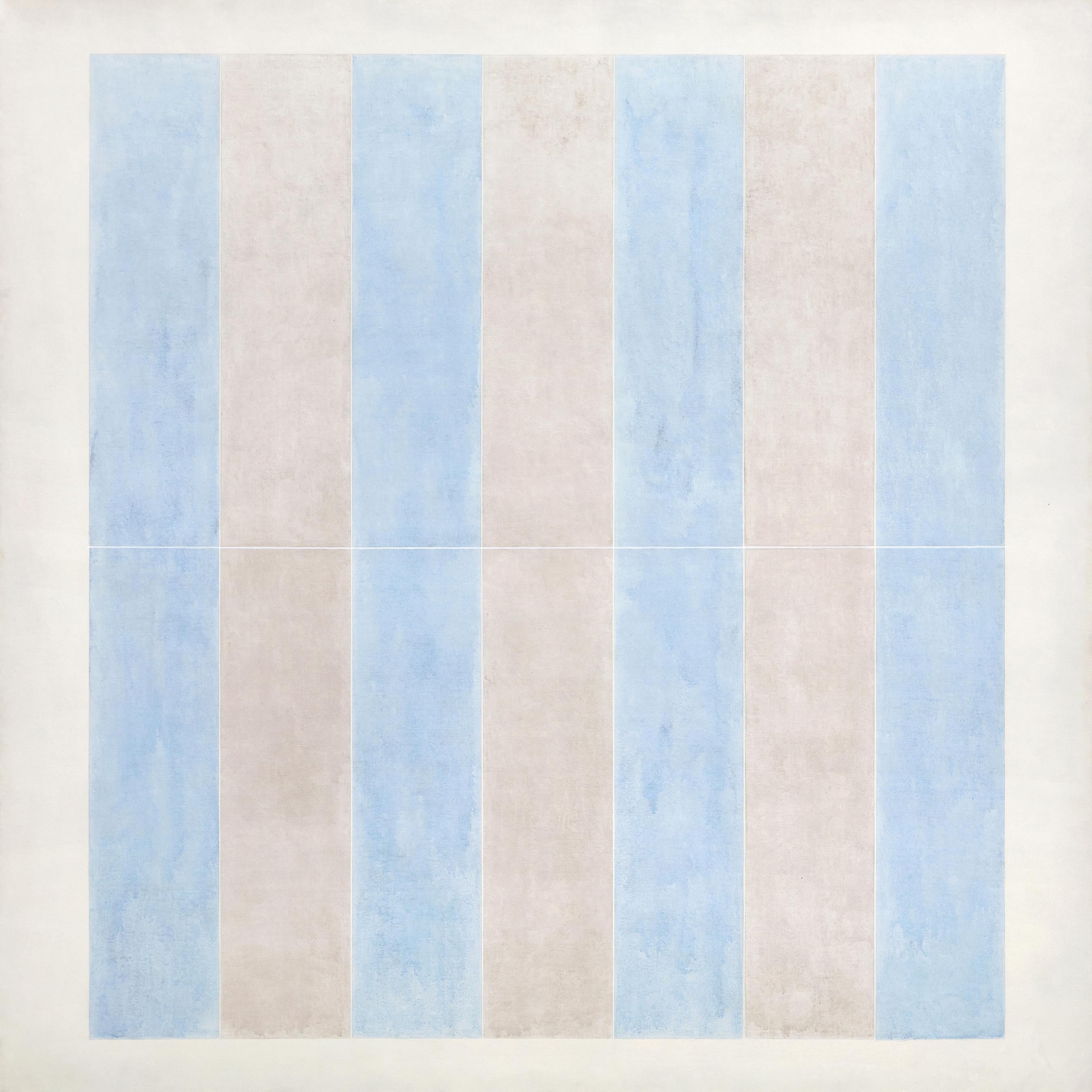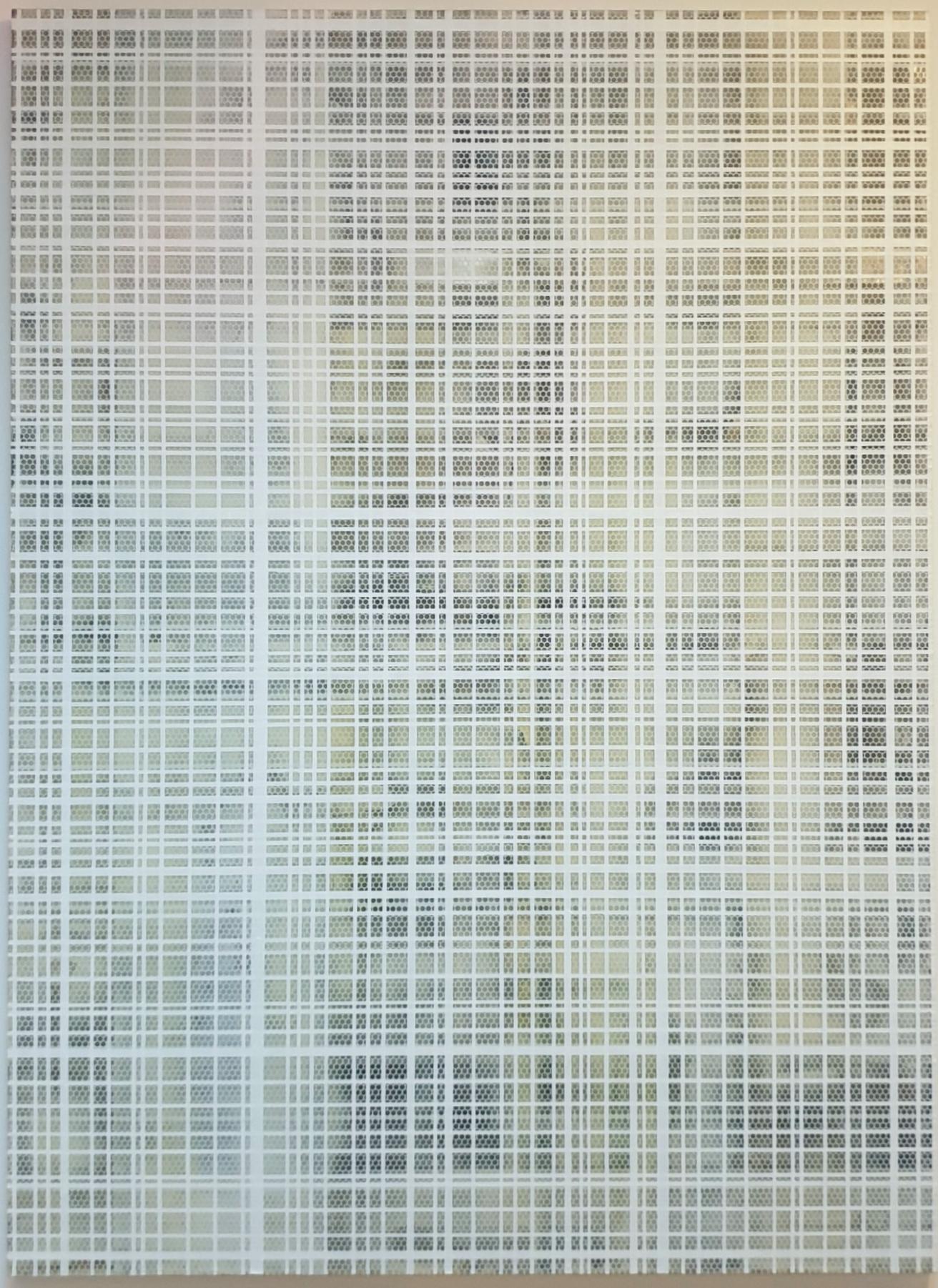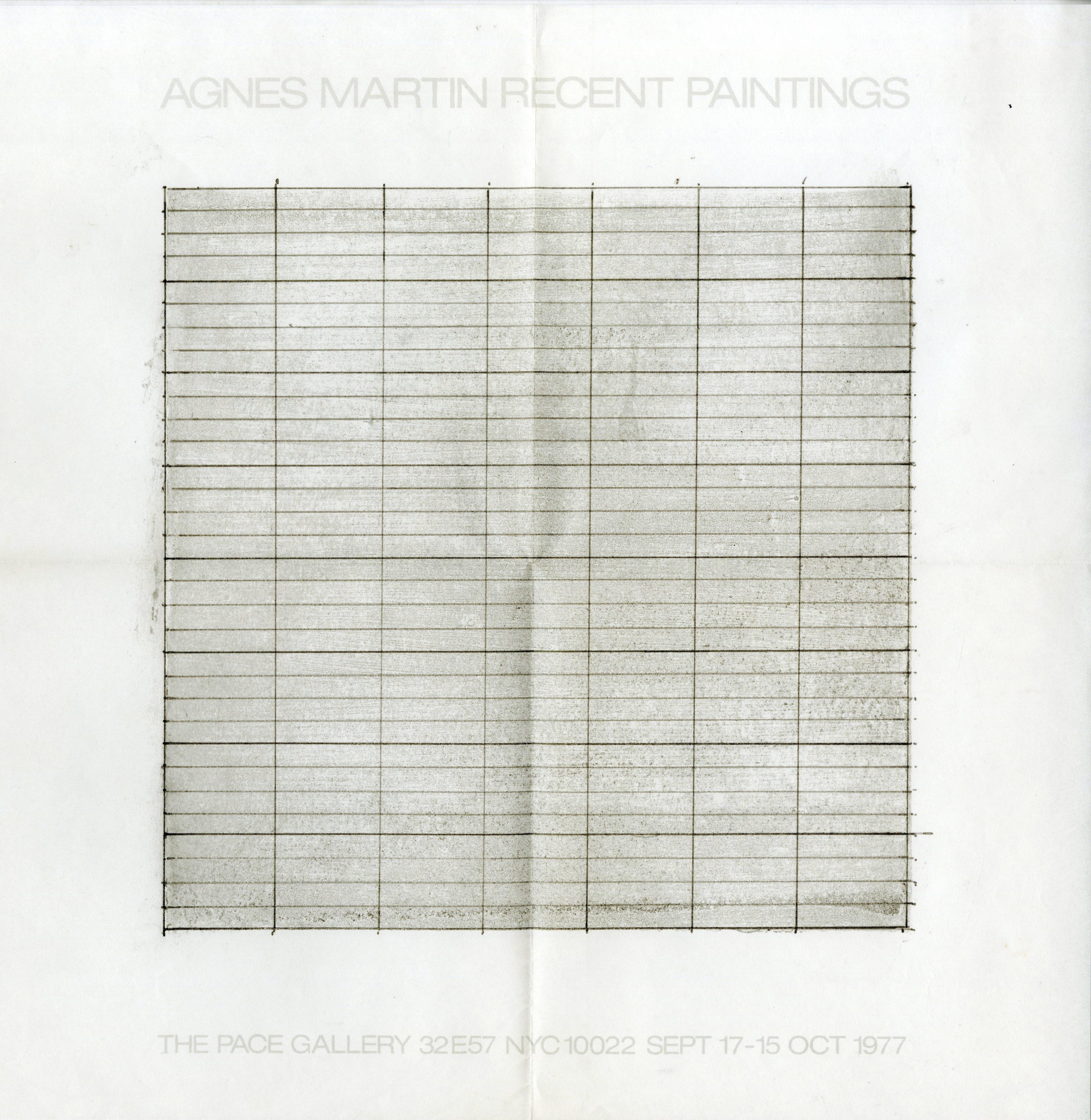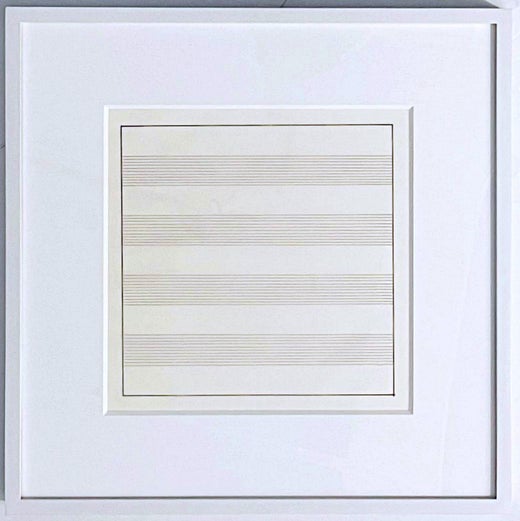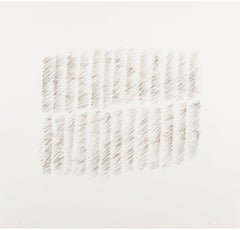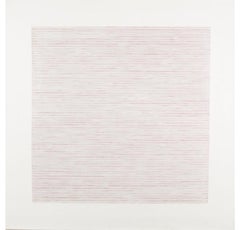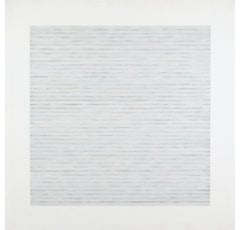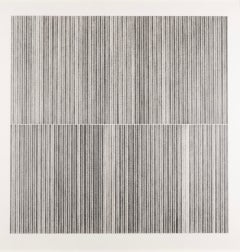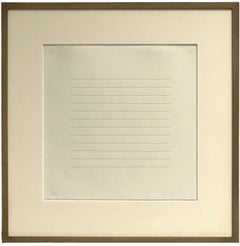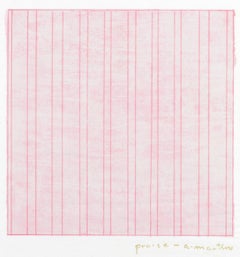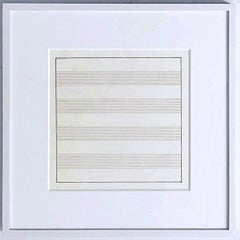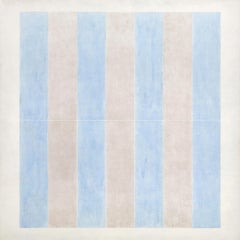Items Similar to Paintings and Drawings, by Agnes Martin 1974-1990 (Stedelijk), 1991
Want more images or videos?
Request additional images or videos from the seller
1 of 6
Agnes MartinPaintings and Drawings, by Agnes Martin 1974-1990 (Stedelijk), 19911991
1991
$12,068
£8,800
€10,291.51
CA$16,854.50
A$18,291.28
CHF 9,624.09
MX$222,239.55
NOK 120,491.76
SEK 113,453.96
DKK 76,842.06
About the Item
Paintings and Drawings, by Agnes Martin 1974-1990 (Stedelijk), 1991
Additional information:
Medium: complete set of ten lithographs on transparent vellum paper
each, 30 x 30 cm
11 3/4 x 11 3/4 in
Agnes Martin was an American painter who was born in Macklin, Saskatchewan, Canada, in 1912, and became a US citizen in 1940. Martin is perhaps most recognised for her evocative paintings marked out in subtle pencil lines and pale colour washes. Although restrained, her style was underpinned by her deep conviction in the emotive and expressive power of art. Martin believed that spiritual inspiration and not intellect created great work. ‘Without awareness of beauty, innocence and happiness’ Martin wrote ‘one cannot make works of art’.
In a career spanning five decades, Martin became known for her square canvasses, meticulously rendered grids and repeat stripes, though her lesser-known early works consist of experiments with mixed media and works on paper. Martin thought of her works as studies in the pursuit of perfection.
Martin spent many years working in New York, where she was part of a contemporary of artists such as Sol LeWitt, Ann Truitt, Donald Judd and Ad Reinhardt – with whom she was close friends. In 1967, shortly after Reinhardt died and just as Martin’s art was gaining acclaim, she left the city and continued her investigations into Buddhism and meditation. She wished to experience true solitude and used this period of quiet reflection to produce some of her most significant writing, whilst situated in sparsely populated and remote areas of the United States and Canada. In 1968 Martin resettled in New Mexico and began building an adobe and log house in a remote mesa. She lived there alone and without modern conveniences for several years. In 1973 she began creating work again.
Agnes Martin’s influence reaches globally and plays a hugely significant role in 20th Century art history. Whilst known as a pioneer of abstract painting, her work as well as her reclusive lifestyle have served as an inspiration to creative practitioners in diverse disciplines. Painters, photographers, writers – and many devotees from the words of fashion, architecture and graphic design revisit and rephrase her perspectival studies and fascination with geometry, the legacy of which can be seen in investigations into brevity of line and muted colour palettes. Artists such as Richard Tuttle, Ellen Gallagher and Roni Horn cite Martin as a central figure in their research and practice.
- Creator:Agnes Martin (1912-2004, American)
- Creation Year:1991
- Dimensions:Height: 11.75 in (29.85 cm)Width: 11.75 in (29.85 cm)
- Medium:
- Period:
- Condition:
- Gallery Location:Kingsclere, GB
- Reference Number:1stDibs: LU2718214578392
Agnes Martin
Born on a farm in rural Saskatchewan, Canada, Agnes Martin immigrated to the United States in 1932 in the hopes of becoming a teacher. After earning a degree in art education, she moved to the desert plains of Taos, New Mexico, where she made abstract paintings with organic forms, which attracted the attention of renowned New York gallerist Betty Parsons, who convinced the artist to join her roster and move to New York in 1957. There, Martin lived and worked on Coenties Slip, a street in Lower Manhattan, alongside a community of artists—including Robert Indiana, Ellsworth Kelly, and Jack Youngerman—who were all drawn to the area’s cheap rents, expansive loft spaces and proximity to the East River. Harbor Number 1 (1957), one of Martin’s earliest New York paintings, combines the geometric abstraction of her earlier Taos work with the newfound inspiration of the harbor landscape, evident in her choice of blue-gray palette. Over the course of the next decade, Martin developed her signature format: six by six foot painted canvases, covered from edge to edge with meticulously penciled grids and finished with a thin layer of gesso. Though she often showed with other New York abstractionists, Martin’s focused pursuit charted new terrain that lay outside of both the broad gestural vocabulary of Abstract Expressionism and the systematic repetitions of Minimalism. Rather, her practice was tethered to spirituality and drew from a mix of Zen Buddhist and American Transcendentalist ideas. For Martin, painting was “a world without objects, without interruption… or obstacle. It is to accept the necessity of … going into a field of vision as you would cross an empty beach to look at the ocean.”1 In 1967, at the height of her career, Martin faced the loss of her home to new development, the sudden death of her friend Ad Reinhardt, and the growing strain of mental illness; she left New York, and returned to Taos, where she abandoned painting, instead pursuing writing and meditation in isolation. Her return to painting in 1974 was marked by a subtle shift in style: no longer defined by the delicate graphite grid, compositions such as Untitled Number 5 (1975) display bolder geometric schemes—like distant relatives of her earliest works. In these late paintings, Martin evoked the warm palette of the arid desert landscape where she remained for the rest of her life.
About the Seller
No Reviews Yet
Vetted Professional Seller
Every seller passes strict standards for authenticity and reliability
Established in 2010
1stDibs seller since 2024
41 sales on 1stDibs
Typical response time: 8 hours
- ShippingRetrieving quote...Shipping from: Kingsclere, United Kingdom
- Return Policy
Authenticity Guarantee
In the unlikely event there’s an issue with an item’s authenticity, contact us within 1 year for a full refund. DetailsMoney-Back Guarantee
If your item is not as described, is damaged in transit, or does not arrive, contact us within 7 days for a full refund. Details24-Hour Cancellation
You have a 24-hour grace period in which to reconsider your purchase, with no questions asked.Vetted Professional Sellers
Our world-class sellers must adhere to strict standards for service and quality, maintaining the integrity of our listings.Price-Match Guarantee
If you find that a seller listed the same item for a lower price elsewhere, we’ll match it.Trusted Global Delivery
Our best-in-class carrier network provides specialized shipping options worldwide, including custom delivery.More From This Seller
View AllShaded Grey by Kim Lim, 1993 - Minimalist Textural Print, White and Grey
By Kim Lim
Located in Kingsclere, GB
Shaded Grey by Kim Lim, 1993
Additional information:
Medium: lithograph
52.5 x 56 cm
20 5/8 x 22 1/8 in
signed, dated and numbered 20/20 in pencil
Kim Lim was born in Singapore and spent much of her early childhood in Penang and Malacca. After her schooling in Singapore, Lim knew that she wanted to become an artist, and at eighteen, she enrolled at St. Martin's in London, where she spent two years concentrating mainly on wood carving. She then transferred to the Slade, where taught by the etcher Anthony Gross and lithographer Stanley Jones, she developed a strong commitment to print making.
On journeys back to Singapore she stopped off in Europe and India, soaking up the art 'like a sponge'. These were the experiences that confirmed in her a lifelong predilection for things archaic, and for the flow and rhythm of Indian and South East Asian sculpture: " I found that I always responded to things that were done in earlier civilizations that seemed to have less elaboration and more strength." In Greece she was entranced by Cycladic sculpture. Of Chinese art she was moved most by early Shang bronzes, Han sculpture, Sung pottery...
Category
20th Century Abstract Prints
Materials
Lithograph
ENMXI (White Painting), Oil on Canvas by Richard Allen, 1995 circa
By Richard Allen
Located in Kingsclere, GB
ENMXI (White Painting), Oil on Canvas by Richard Allen, 1995 circa
Additional information:
Medium: Oil on canvas
61 x 61 cm
24 x 24 in
With Estate stamp on the overlap
Richard Allen was an Abstract artist of the 20th century who worked across painting, graphic and technological media.
Allen was born in Worcester in 1933. Influenced by his father, he attended Shropshire Institute of Agriculture where he studied for a National Diploma. From there he became aware of what he considered his “irrational” yet unshakeable interest in art, since the College shared buildings with Worcester School of Art. Upon the advice of his window-cleaner Bob, Allen decided to apply to the School. Whilst in Worcester he attended Geoffrey Whiting...
Category
20th Century Abstract Paintings
Materials
Canvas
VIII (White Painting ENW17), Oil on Canvas by Richard Allen, 1995 circa
By Richard Allen
Located in Kingsclere, GB
VIII (White Painting ENW17), Oil on Canvas by Richard Allen, 1995 circa
Additional information:
Medium: Oil on canvas
24 1/8 x 24 1/8 in
61 x 61 cm
With Estate stamp on overlap
Richard Allen was an Abstract artist of the 20th century who worked across painting, graphic and technological media.
Allen was born in Worcester in 1933. Influenced by his father, he attended Shropshire Institute of Agriculture where he studied for a National Diploma. From there he became aware of what he considered his “irrational” yet unshakeable interest in art, since the College shared buildings with Worcester School of Art. Upon the advice of his window-cleaner Bob, Allen decided to apply to the School. Whilst in Worcester he attended Geoffrey Whiting’s pottery course. Allen took national service in 1952 during the Korean War, serving as an engineer.
He returned to Worcester in 1954 to study for his A levels and NDD, after which he attended Bath Academy of Art, Corsham, in 1957. He embraced Bath's unconventional teaching of that time and developed a keen interest in abstract painting. In 1959, his last year at Bath, he was commissioned to make a 15 x 9 foot abstract mosaic for a Wiltshire college, in which the first signs of Allen's grid construction, and blocks of colour within a grid, are seen to appear. In 1960 he won an Italian Government Scholarship in Art to study in Ravenna. After only three months in Ravenna, working on restoration of Byzantine mosaics, he moved to the more lively city of Milan in which he worked with large-scale mosaic production. These commercialised mosaics informed his later works, and Allen considers his time in Milan to be one of fruitful cultural interaction.
He married fellow Bath Academy of Art student Eve Laurens the next year, and began teaching part time. He taught at Croydon College of Art for eight years, during which time he began working on his Op Art paintings and was awarded the title of Commonwealth Scholar in Art and Architecture. The scholarship gave him the opportunity to study in the Indian Institute for Advanced Studies in Shimla for a year, during which he was able to travel India extensively.
During his time in London Allen worked alongside such figures as Bridget Riley and Bruce McLean, their commitment to artistic professionalism informing his own identity as an artist. Allen started experimenting with line, colour, optical effects and the relationship between art and science. His Op Art works relied upon Interferometry, allowing him to lay grid lines over paintings to create visual manipulations. In 1967 he had his first solo exhibition at the University of Sussex. In 1971 he was invited by Malcolm Hughes to join the Matrix group of artists, whose exhibition opened at the Arnolfini Gallery that year which led to a further exhibition at the Whitechapel gallery the following year. The Matrix group was concerned with Systematic painting, which worked to create images that consciously reveal their own methods of construction. This led to his involvement with the Systems movement in music, with performances often accompanying the openings of System exhibitions. Concern with systems informed Allen’s work throughout his life.
In 1972 Allen returned to graphic works, namely making large-scale charcoal pieces on canvas. His work at this time was still very much based on the grid and cross. His work was included in the Hayward gallery British painting Exhibition in the mid 1970s, and was also displayed in a solo exhibition at the London Institute of Contemporary Arts. Allen moved to Jersey in 1977, where he continued working with charcoal and exhibiting internationally. The minimalist exhibition ‘Fundamental Painting’ in Amsterdam, 1975, inspired Allen to put together a similar English exhibition. His position on the Committee of the Art Information Registry/Air and Space, enabled him to work on this. The exhibition was held in the Air Gallery in Charing Cross and led to his curation of Fundamental Painting exhibitions in Holland, Belgium, France and Italy.
In 1991 he returned to England and began working on his "white paintings", having not worked with colour for twenty years, which were to be his last works. Shortly after his wife Eve died in 1997 he was diagnosed with Motor Neuron Disease. Allen began working with specially adapted computer software...
Category
20th Century Abstract Paintings
Materials
Canvas
Untitled - Contemporary Monochrome Minimalist Square Drawing in Grey and White
By Jon Probert
Located in Kingsclere, GB
Jon Probert b. 1966
Untitled, 2024
pencil drawing
58.5 x 58.5 cm
23 x 23 in
signed verso
Having studied Fine Art and Art History at Newcastle University and lived in London for many...
Category
21st Century and Contemporary Abstract Drawings and Watercolors
Materials
Paper, Pencil
Summer, from The Four Seasons, 1966 - Minimalist White Screen Print
By Richard Lin
Located in Kingsclere, GB
Summer, from The Four Seasons by Richard Lin, 1966
Additional information:
Medium: screenprint on TH Saunders paper
68.5 x 91 cm
27 x 35 7/8 in
signed, dated twice, titled and inscr...
Category
20th Century Abstract Prints
Materials
Screen
XXV (White Painting ENW9), Oil on Canvas by Richard Allen, 1995 circa
By Richard Allen
Located in Kingsclere, GB
XXV (White Painting ENW9), Oil on Canvas by Richard Allen, 1995 circa
Additional information:
Medium: Oil on canvas
24 1/8 x 24 1/8 in
61 x 61 cm
With Estate stamp on overlap
Richard Allen was an Abstract artist of the 20th century who worked across painting, graphic and technological media.
Allen was born in Worcester in 1933. Influenced by his father, he attended Shropshire Institute of Agriculture where he studied for a National Diploma. From there he became aware of what he considered his “irrational” yet unshakeable interest in art, since the College shared buildings with Worcester School of Art. Upon the advice of his window-cleaner Bob, Allen decided to apply to the School. Whilst in Worcester he attended Geoffrey Whiting’s pottery course. Allen took national service in 1952 during the Korean War, serving as an engineer.
He returned to Worcester in 1954 to study for his A levels and NDD, after which he attended Bath Academy of Art, Corsham, in 1957. He embraced Bath's unconventional teaching of that time and developed a keen interest in abstract painting. In 1959, his last year at Bath, he was commissioned to make a 15 x 9 foot abstract mosaic for a Wiltshire college, in which the first signs of Allen's grid construction, and blocks of colour within a grid, are seen to appear. In 1960 he won an Italian Government Scholarship in Art to study in Ravenna. After only three months in Ravenna, working on restoration of Byzantine mosaics, he moved to the more lively city of Milan in which he worked with large-scale mosaic production. These commercialised mosaics informed his later works, and Allen considers his time in Milan to be one of fruitful cultural interaction.
He married fellow Bath Academy of Art student Eve Laurens the next year, and began teaching part time. He taught at Croydon College of Art for eight years, during which time he began working on his Op Art paintings and was awarded the title of Commonwealth Scholar in Art and Architecture. The scholarship gave him the opportunity to study in the Indian Institute for Advanced Studies in Shimla for a year, during which he was able to travel India extensively.
During his time in London Allen worked alongside such figures as Bridget Riley and Bruce McLean, their commitment to artistic professionalism informing his own identity as an artist. Allen started experimenting with line, colour, optical effects and the relationship between art and science. His Op Art works relied upon Interferometry, allowing him to lay grid lines over paintings to create visual manipulations. In 1967 he had his first solo exhibition at the University of Sussex. In 1971 he was invited by Malcolm Hughes to join the Matrix group of artists, whose exhibition opened at the Arnolfini Gallery that year which led to a further exhibition at the Whitechapel gallery the following year. The Matrix group was concerned with Systematic painting, which worked to create images that consciously reveal their own methods of construction. This led to his involvement with the Systems movement in music, with performances often accompanying the openings of System exhibitions. Concern with systems informed Allen’s work throughout his life.
In 1972 Allen returned to graphic works, namely making large-scale charcoal pieces on canvas. His work at this time was still very much based on the grid and cross. His work was included in the Hayward gallery British painting Exhibition in the mid 1970s, and was also displayed in a solo exhibition at the London Institute of Contemporary Arts. Allen moved to Jersey in 1977, where he continued working with charcoal and exhibiting internationally. The minimalist exhibition ‘Fundamental Painting’ in Amsterdam, 1975, inspired Allen to put together a similar English exhibition. His position on the Committee of the Art Information Registry/Air and Space, enabled him to work on this. The exhibition was held in the Air Gallery in Charing Cross and led to his curation of Fundamental Painting exhibitions in Holland, Belgium, France and Italy.
In 1991 he returned to England and began working on his "white paintings", having not worked with colour for twenty years, which were to be his last works. Shortly after his wife Eve died in 1997 he was diagnosed with Motor Neuron Disease. Allen began working with specially adapted computer software...
Category
20th Century Abstract Paintings
Materials
Canvas
You May Also Like
On a Clear Day #15 1973
By Agnes Martin
Located in Rochester Hills, MI
Artist: Agnes Martin
Title: On a Clear Day #15
Year: 1973
Screenprint Japanese Rag paper Image size: 6 7/8 x 8 inches (17.5 x 20.3 cm)
Paper size: 12 x 12 inches (30.5 x 30.5 cm)
Fra...
Category
1970s Minimalist Abstract Prints
Materials
Screen
Praise, Rubber Stamp Portfolio, Agnes Martin
By Agnes Martin
Located in Southampton, NY
Printer’s ink from rubber stamp on vélin Dalton natural bond paper. Paper Size: 8 x 8 inches. Inscription: Unsigned, as issued. Notes: From the folio, Rubber Stamp Portfolio, 1977. P...
Category
1970s Minimalist Abstract Prints
Materials
Printer's Ink
Untitled #10, Minimalist lithograph on vellum transparency paper Lt. Ed., Framed
By Agnes Martin
Located in New York, NY
Agnes Martin
Untitled #10, 1990
Lithograph on vellum transparency paper
Unsigned
Limited Edition of 2500
Publisher: Nemela & Lenzen GmbH, Monchengladback & Stedelijk Museum, Amsterda...
Category
1990s Minimalist Abstract Prints
Materials
Vellum, Lithograph
Untitled No. 7
By Agnes Martin
Located in Palm Desert, CA
"Untitled No. 7" is an abstract Post War acrylic, pencil and gesso on canvas by Agnes Martin in 1974. The artwork is 72 x 72 inches and, with the frame, is 72 3/8 x 72 3/8 x 1 1/2 in...
Category
20th Century Post-War Abstract Paintings
Materials
Gesso, Canvas, Acrylic, Pencil
Price Upon Request
Untitled Hiding Agnes Martin - contemporary modern abstract painting on canvas
By Eliza Kopec
Located in Doetinchem, NL
Untitled Hiding Agnes Martin is a unique contemporary modern painting by renowned Polish-Dutch artist Eliza Kopec. The painting is a typical example of her preferred minimalist abstr...
Category
2010s Contemporary Abstract Paintings
Materials
Canvas, Acrylic, Polymer
Agnes Martin Recent Paintings Limited Edition 1977 PACE Gallery invite on vellum
By Agnes Martin
Located in New York, NY
Agnes Martin Recent Paintings, 1977
Offset Lithograph invitation on Vellum
12 × 12 inches
Edition of 2000
Unframed
This early print is an exhibition invitation to the Pace Gallery's 1977 Agnes Martin show in New York. The image is a reproduction of a painting from the show, approved by Martin to be used on the invitation to the show. It is printed on a fragile, almost transparent vellum that captures the delicate power of the art. Less than 2000...
Category
1970s Abstract Geometric Abstract Prints
Materials
Offset, Lithograph
More Ways To Browse
Adobe House
Agnes Martin Print
Agnes Martin Lithographs
Jewish Pop Art
Joan Miro Barcelona Lithograph
Joan Miro Large
Joan Miro Limited Edition
Joan Mitchell Lithograph
Kenneth Noland Lithograph
Manoela Madera
Matisse Pochoir
Matsutani Takesada
Miro Sobreteixims
Mr Doodle
Noemi Gerstein
Peter Max Flower Abstract
Pia Stern
Print Signed Whitney
